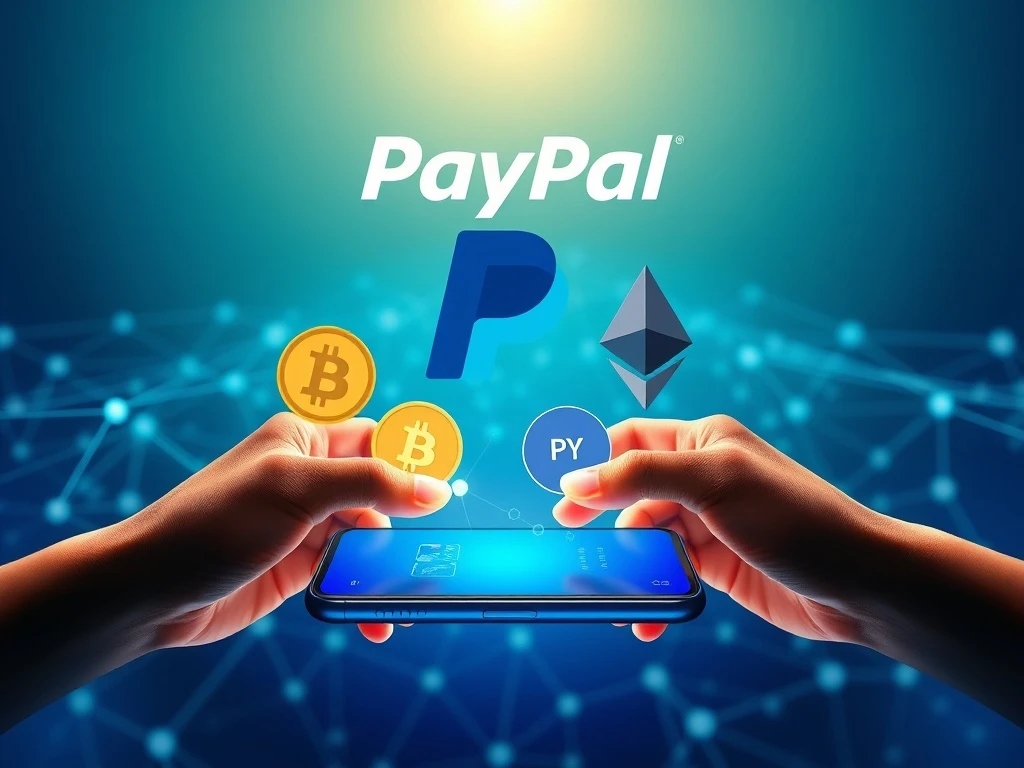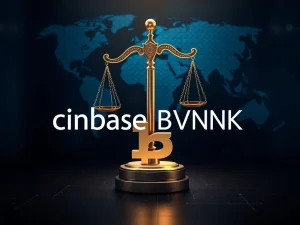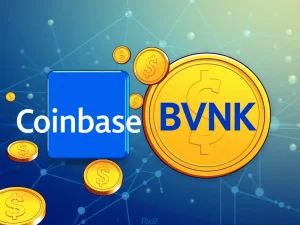PayPal Crypto Payments: Unlocking a Revolutionary Era of P2P Transfers

The financial world is witnessing a significant shift. PayPal, a global payments giant, recently announced a groundbreaking move. It will integrate major cryptocurrencies like Bitcoin (BTC), Ether (ETH), and its native stablecoin, PYUSD, into its peer-to-peer (P2P) payment system. This development marks a pivotal moment for mainstream crypto adoption. It transforms how users can interact with digital assets beyond mere investment. This expansion of PayPal crypto payments directly addresses the growing demand for practical cryptocurrency utility.
PayPal Crypto Payments: A New Frontier in P2P Transfers
PayPal, boasting over 400 million active accounts, is enhancing its P2P payment capabilities. Users can now send and receive digital assets directly. This functionality moves cryptocurrencies beyond trading platforms. It makes them a practical tool for everyday transactions. The company introduced “PayPal links” on Monday. These personalized, one-time links are generated within the PayPal app. Users can share them via text, email, or chat. The feature first launches in the US. It will then expand to the United Kingdom, Italy, and other international markets later this year. This phased rollout ensures a smooth transition. The immediate plan allows users to send cryptocurrencies and stablecoins through PayPal’s P2P feature. This includes transfers to both PayPal and Venmo users. It also supports compatible external digital asset wallets. The supported cryptocurrencies will prominently feature Bitcoin PayPal, Ether PayPal, and PYUSD integration.
This initiative represents a strategic step for PayPal. It solidifies its position in the evolving digital finance landscape. The ability to directly transfer these assets simplifies the user experience. It removes many traditional barriers to crypto adoption. Therefore, millions of new users might explore digital assets for the first time. The focus on direct transfers aligns with the original vision of cryptocurrency. It promotes a more decentralized approach to financial transactions, even within a centralized system.
Understanding PYUSD Integration and Its Impact
PayPal’s dollar-pegged stablecoin, PYUSD, plays a crucial role in this new payment push. PYUSD has already gained substantial traction in the market. Its market capitalization recently approached $1.3 billion. This growth underscores its increasing acceptance and utility. The PYUSD integration into PayPal’s P2P system provides a stable option for digital transfers. Stablecoins offer the benefits of blockchain technology with price stability. This makes them ideal for everyday transactions and remittances. Users can send value without the volatility associated with other cryptocurrencies.
PayPal’s dollar-pegged stablecoin, PYUSD, has gained significant traction, with its market cap reaching nearly $1.3 billion. Source: CoinMarketCap
PayPal also clarified important tax considerations. Personal transfers made through Venmo or PayPal will not trigger 1099-K tax reporting. This is because friends-and-family payments are generally exempt. This clarity is vital for user confidence. Both PayPal links and the crypto P2P capability fall under “PayPal World.” This is the company’s new interoperability framework. It connects wallets and payment systems across international borders. Such a framework is essential for global digital asset fluidity. It enables seamless transactions worldwide.
Accelerating Mainstream Adoption Through P2P Crypto Transfers
PayPal has steadily expanded its presence in the digital asset space. Earlier this year, it launched “Pay with Crypto.” This blockchain-based settlement service allows US businesses to accept over 100 cryptocurrencies. In April, PayPal broadened its Venmo and PayPal crypto offerings. It included Chainlink (LINK) and Solana (SOL). These previous moves paved the way for the current P2P crypto transfers initiative. The company understands the evolving demands of its user base. Consequently, it continuously adapts its services.
Peer-to-peer payments have long been a core promise of cryptocurrency. Satoshi Nakamoto’s original Bitcoin white paper emphasized this utility. In its purest form, P2P refers to direct wallet-to-wallet transfers. These occur on a blockchain, free of intermediaries. While PayPal remains a centralized payment processor, its new P2P platform offers a hybrid solution. Users can send cryptocurrencies to external wallets. This feature aligns more closely with the original ethos of peer-to-peer transactions. It provides a bridge between traditional finance and decentralized digital assets. This blend of security and accessibility could be transformative. It truly gives utility to one of crypto’s core promises.
The Growing Landscape of Bitcoin PayPal and Ether PayPal Utility
PayPal is not the only centralized player embracing digital assets. In June, crypto exchange Kraken introduced Krak. This payments app enables users to send and receive digital assets across borders. These developments highlight a broader industry trend. Financial institutions are recognizing the potential of cryptocurrencies. They are actively integrating them into their services. This competition benefits consumers. It drives innovation and improves user experience.
The rise of stablecoins is also reshaping remittances and P2P payments significantly. The World Bank has noted the efficiency gains. Stablecoin-based rails could cut transaction costs by as much as 92%. This reduction in fees is especially impactful for international transfers. It benefits migrant workers and businesses alike. For instance, sending Bitcoin PayPal or Ether PayPal to family abroad becomes more feasible. However, not everyone shares this optimistic view. The Bank for International Settlements (BIS) has voiced caution. They argue that stablecoins fall short on key monetary principles. They suggest stablecoins behave more like financial assets than true currency. This ongoing debate highlights the complexities of integrating digital assets into traditional financial systems. It also emphasizes the need for careful regulation and robust infrastructure.
Paving the Way for a Digital Future with PayPal Crypto Payments
PayPal’s integration of BTC, ETH, and PYUSD into its P2P payment system is a landmark event. It signifies a major step towards mainstream cryptocurrency adoption. This move provides millions of users with direct access to digital asset transfers. It makes cryptocurrencies more accessible and practical. The introduction of PayPal links and direct crypto transfers simplifies the user journey. It aligns with the original vision of peer-to-peer digital cash. While challenges and debates surrounding stablecoins persist, PayPal’s commitment is clear. The company aims to be at the forefront of digital finance. This development could inspire other major payment processors to follow suit. Consequently, it accelerates the global shift towards a more interconnected and efficient financial ecosystem.







